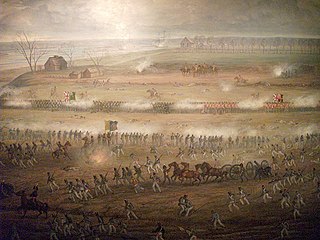
The Battle of Crysler's Farm, also known as the Battle of Crysler's Field, was fought on 11 November 1813, during the War of 1812. A British and Canadian force won a victory over a US force which greatly outnumbered them. The US defeat prompted them to abandon the St. Lawrence Campaign, their major strategic effort in the autumn of 1813.
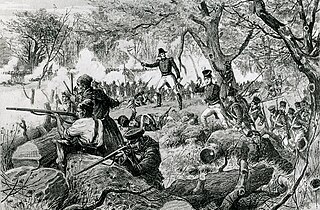
The Battle of the Chateauguay was an engagement of the War of 1812. On 26 October 1813, a combined British and Canadian force consisting of 1,530 regulars, volunteers, militia and Mohawk warriors from Lower Canada, commanded by Charles de Salaberry, repelled an American force of about 2,600 regulars which was attempting to invade Lower Canada and ultimately attack Montreal.

The siege of Fort Erie, also known as the Battle of Erie, from 4 August to 21 September 1814, was one of the last engagements of the War of 1812, between British and American forces. It took place during the Niagara campaign, and the Americans successfully defended Fort Erie against a British army. During the siege, the British suffered high casualties in a failed storming attempt; they also suffered casualties from sickness and exposure in their rough encampments. Unaware that the British were about to abandon the siege, the American garrison launched a sortie to destroy the British siege batteries, during which both sides again suffered high losses.

The Battle of Ogdensburg was a battle of the War of 1812. The British gained a victory over the Americans and captured the village of Ogdensburg, New York. Although small in scale, it removed the American threat to British supply lines for the remainder of the war.

The King's Royal Regiment of New York, also known as Johnson's Royal Regiment of New York, King's Royal Regiment, King's Royal Yorkers, and Royal Greens, were one of the first Loyalist regiments, raised on June 19, 1776, in British Canada, during the American Revolutionary War.

Stormont, Dundas and Glengarry Highlanders is a Primary Reserve infantry regiment of the Canadian Army. It is part of 33 Canadian Brigade Group, 4th Canadian Division and is headquartered in Cornwall, Ontario.

The Battle of Lacolle Mills was fought on 30 March 1814 during the War of 1812. The small garrison of a British outpost position, aided by reinforcements, fought off a large American attack.

When the United States and the United Kingdom went to war against each other in 1812, the major land theatres of war were Upper Canada, Michigan Territory, Lower Canada and the Maritime Provinces of Nova Scotia, New Brunswick, Prince Edward Island and Cape Breton . Each of the separate British administrations formed regular and fencible units, and both full-time and part-time militia units, many of which played a major part in the fighting over the two and a half years of the war.

The following is a synopsis of the land campaigns of the War of 1812.

Fort Wellington National Historic Site is a historic military fortification located on the north shore of the St. Lawrence River at Prescott, Ontario. The military fortification was used by the British Army, and the Canadian militia for most of the 19th century, and by the militia in the 20th century, until 1923, when the property was handed over to the Dominion Parks Commission, the predecessor to Parks Canada. The fort was earlier named a National Historic Site of Canada in January 1920.
The Battle of Malcolm's Mills was the last battle of the War of 1812 fought in the Canadas. A force of American mounted troops overran and scattered a force of Canadian militia. The battle was fought on November 6, 1814, near the village of Oakland in Brant County, Upper Canada, and was part of a series of battles fought by American Brigadier General Duncan McArthur on an extended raid into Upper Canada, known variously as McArthur's Raid or Dudley's Raid. Marching over 200 miles (320 km) into Canada, the Americans returned to Detroit on November 17 after 11 days of raiding the Ontario Peninsula.
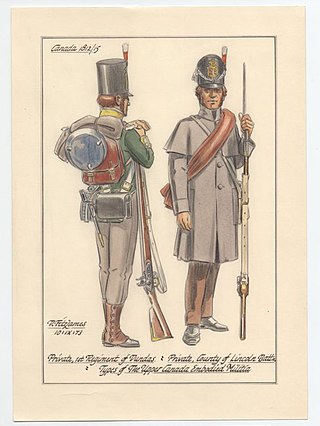
The Dundas County Militia was a regiment of the provincial militia of Upper Canada that was raised in Dundas County, Ontario, in the 1780s. The battle honours and legacy of the Dundas Militia are perpetuated by the Stormont, Dundas and Glengarry Highlanders.
The Battle of French Mills or First Salmon River Raid was a raid and battle fought on November 22, 1812. 100 American soldiers stationed at French Mills led a successful attack against 45 Canadian voyageurs on 22 October at the Battle of St. Regis. Half returned to French Mills while the other half departed for Plattsburgh, New York. In retribution, a mix of Canadian regulars and militia amounting to 150 men attacked the 50 Americans at French Mills forcing their surrender.
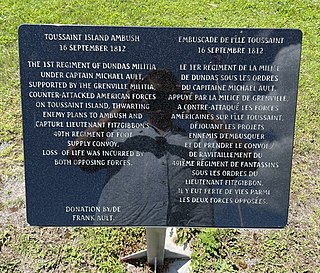
The Battle of Matilda, also known as the Battle of Toussaint's Island, was an early skirmish of the War of 1812 fought on September 16, 1812 between American and Canadian militia in the St. Lawrence River near the township of Matilda, in Dundas County.
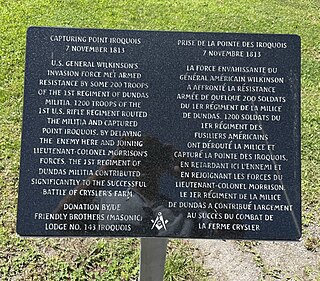
The Battle of Point Iroquois was a small skirmish fought on the morning of November 8, 1813, as part of Wilkinson's advance up the St. Lawrence towards Montreal. The skirmish occurred on the shores of the St. Lawrence River at Point Iroquois, Dundas County, where the river reached its narrowest point, only 500 yards across.
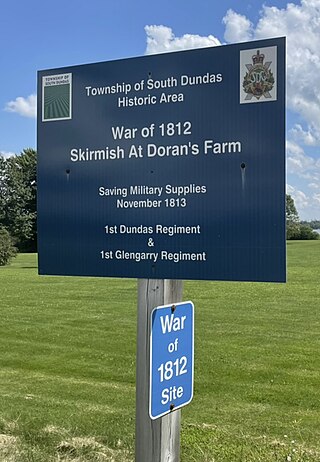
The Skirmish at Doran's Farm was a small skirmish during the War of 1812 fought during Wilkinson's advance up the St. Lawrence.

The Occupation of Cornwall was the capture and occupation of the town of Cornwall following the Battle of Crysler's Farm.
The Raid on Madrid was a small raid by Canadian Militia and Royal Marines on the village of Madrid, New York, during the War of 1812.
The Assault on Ogdensburg, also known as the First Battle of Ogdensburg or the Battle of Prescott, was an attack by Canadian militia on the American defences at Ogdensburg on October 4, 1812.













